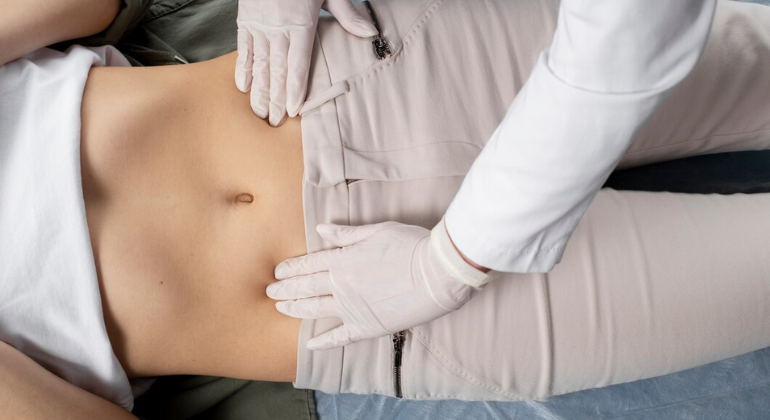Navel displacement, also referred to as “navel misalignment” or “nabhi displacement,” occurs when the navel (belly button) shifts from its natural central position. This condition can cause discomfort in the abdomen, digestive irregularities, and even radiating pain in other parts of the body. While it’s not a life-threatening condition, navel displacement can affect your daily life if left untreated.
The good news is that navel displacement recovery is possible through natural methods, including simple exercises, home remedies, and lifestyle adjustments. In this blog, we’ll answer key questions like what causes navel displacement, how to identify the symptoms, and what you can do to recover naturally.
What Is Navel Displacement, and Why Does It Happen?
Navel displacement occurs when the abdominal muscles lose alignment, causing the belly button to shift from its natural position. This condition is typically triggered by physical strain, lifestyle habits, or health conditions.
Common Causes of Navel Displacement

Here are the most common triggers behind navel misalignment:
- Heavy Lifting or Physical Strain
- Carrying heavy objects without proper technique can overstretch or strain abdominal muscles, leading to displacement.
- Intense physical activities like jumping or twisting motions can also disrupt the navel’s alignment.
- Digestive Problems
- Chronic constipation, bloating, or excessive gas can create abdominal pressure, increasing the likelihood of displacement.
- Irregular bowel movements weaken the abdominal muscles over time.
- Sudden Movements or Accidents
- Sudden jerks, slips, falls, or awkward stretching movements can misalign your core muscles, shifting the navel.
- Weak Abdominal Muscles
- Poor core strength or weak abdominal muscles can make it easier for the navel to shift out of place, especially during strenuous activities.
Symptoms of Navel Displacement You Shouldn’t Ignore
Recognizing the symptoms of navel displacement early is important for proper recovery. Here’s what to look out for:
1. Abdominal Pain and Discomfort
- Pain around the navel area is one of the most common signs. This can be sharp, dull, or intermittent.
2. Digestive Irregularities
- Symptoms like bloating, gas, constipation, or diarrhea are frequently reported by those with navel displacement.
- Many individuals describe a “heavy” sensation in their abdomen.
3. Weakness or Loss of Balance
- Misalignment can interfere with the body’s center of gravity, causing mild balance issues or feelings of physical weakness.
- You may also experience fatigue during physical activities.
4. Radiating Pain
- In some cases, pain can extend beyond the abdomen to the back, hips, or even legs, as the misalignment affects surrounding muscles and nerves.
How to Fix Navel Displacement Naturally
If you’re searching for how to fix navel displacement naturally, there are several remedies and practices that can help. These methods focus on restoring abdominal alignment and reducing discomfort:
1. Gentle Abdominal Massages
- Massage the area around your navel in slow, circular motions to relax tight muscles and promote realignment.
- Use warm coconut oil or sesame oil for better results. Perform this for 10–15 minutes daily.
2. Rest and Recovery
- Rest is essential to allow your abdominal muscles to heal and realign naturally.
- Avoid strenuous activities, heavy lifting, or any movements that strain your core.
3. Use a Warm Compress
- Applying heat to your lower abdomen helps relax muscles and improve blood circulation, which aids recovery.
- Place a heating pad or a warm towel on the affected area for 15–20 minutes.
4. Stay Hydrated and Improve Your Diet
- Drink plenty of water to reduce bloating and support digestion.
- Eat high-fiber foods like fruits, vegetables, and whole grains to maintain regular bowel movements and avoid digestive stress.
Exercises to Realign the Navel and Strengthen Your Core
Specific exercises can help correct navel displacement by strengthening the abdominal muscles and promoting realignment. These are safe, easy to perform at home, and highly effective.
1. Knee-to-Chest Stretch
How to Perform:
- Lie on your back with both legs extended.
- Bend one knee and pull it toward your chest, holding it with your hands.
- Hold for 10–15 seconds, then switch legs.
- Repeat 5–10 times for each leg.
Why It Helps:
This stretch relaxes and strengthens the abdominal muscles, promoting proper alignment.
2. Pelvic Tilt Exercise
How to Perform:
- Lie on your back with your knees bent and feet flat on the floor.
- Tighten your abdominal muscles and tilt your pelvis upward slightly.
- Hold for 5 seconds, then release.
- Perform 10–12 repetitions.
Why It Helps:
Pelvic tilts strengthen the lower abdominal muscles and improve alignment.
3. Cat-Cow Pose
How to Perform:
- Start on your hands and knees in a tabletop position.
- Inhale as you arch your back and lift your head upward (cow pose).
- Exhale as you round your back and tuck your chin to your chest (cat pose).
- Repeat for 8–10 breaths.
Why It Helps:
This pose stretches and strengthens the abdominal and spinal muscles, aiding in realignment.
How Long Does It Take to Recover from Navel Displacement?

Recovery time for navel displacement depends on the severity of the condition and your commitment to remedies and exercises.
- Mild Cases: Often resolve within a few days to a week with rest, massages, and exercises.
- Moderate Cases: May take 2–3 weeks with consistent self-care and physiotherapy.
- Severe Cases: Might require medical intervention and several months of recovery, especially if the condition is accompanied by other health issues.
Pro Tip: Stick to your routine of natural remedies and exercises, and avoid activities that can cause further strain to your abdomen.
Conclusion
Recovering from navel displacement is possible with the right combination of natural remedies, core-strengthening exercises, and a focus on rest and nutrition. By understanding what causes navel displacement, recognizing the symptoms, and following actionable tips on how to fix navel displacement naturally, you can restore your abdominal alignment and regain comfort.
If your symptoms persist or worsen, it’s essential to seek professional help. At Painflame, we specialize in personalized treatment plans and physiotherapy to help you recover quickly and effectively.
Contact Painflame today to take the first step toward pain-free living!
Recent Blog : Knee Pain Recovery Time: How to Heal Faster and Regain Mobility
Frequently Asked Questions (FAQs)
Can navel displacement cause bloating and nausea?
Yes, navel displacement can lead to bloating and nausea because the misalignment of abdominal muscles can disrupt normal digestion. This may cause symptoms like excessive gas, a feeling of heaviness, or even queasiness after meals. Gentle massages, a warm compress, and staying hydrated can help alleviate these symptoms.
Is navel displacement a common issue for athletes?
Yes, athletes are more prone to navel displacement due to intense physical activities like heavy lifting, jumping, or twisting movements that strain the abdominal muscles. Regular core-strengthening exercises, proper warm-ups, and using correct techniques can help prevent the issue.
Can navel displacement recur after recovery?
Yes, navel displacement can recur if the underlying causes, such as weak abdominal muscles or poor posture, are not addressed. To prevent recurrence, it’s important to maintain strong core muscles, avoid lifting heavy objects incorrectly, and practice proper posture during daily activities.
Are there specific foods to avoid during navel displacement recovery?
Yes, avoiding foods that cause bloating, gas, or constipation is recommended during recovery. Limit consumption of processed foods, fried items, carbonated drinks, and dairy if you’re lactose intolerant. Instead, focus on fiber-rich fruits, vegetables, and whole grains to support digestion and reduce abdominal pressure.
Can navel displacement affect menstrual cycles in women?
In some cases, yes. Navel displacement may cause abdominal discomfort or muscle tightness that can mimic or exacerbate menstrual cramps. This misalignment can also create additional tension in the pelvic region, indirectly impacting menstrual symptoms. Addressing the misalignment with massages and exercises can help relieve this discomfort.







